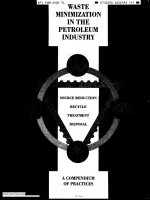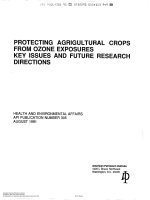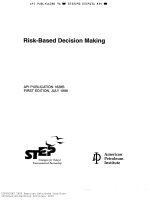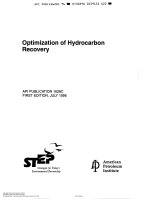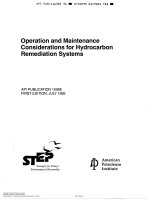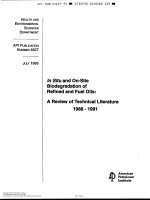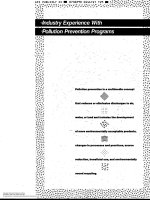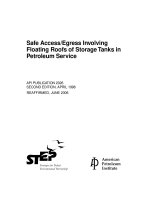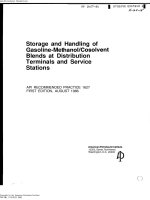Api publ 301 1991 scan (american petroleum institute)
Bạn đang xem bản rút gọn của tài liệu. Xem và tải ngay bản đầy đủ của tài liệu tại đây (6 MB, 54 trang )
Aboveground Storage Tank
Survey
HEALTH AND ENVIRONMENTAL AFFAIRS
API PUBLICATION NUMBER 301
1991
American
Petroleum
Institute
Aboveground Storage Tank Survey
Health and Environmental Affairs Department
PUBLICATION NUMBER 301
PREPARED UNDER CONTRACT BY:
R.A. CHRISTIENSEN
R.F. EILBERT
ENTROPY LIMITED
LINCOLN, MASSACHUSETTS
1991
American
Petroleum
Institute
FOREWORD
API PUBLICATIONS NECESSARILY ADDRESS PROBLEMS OF A GENERAL
NATURE. WITH RESPECT TO PARTICULAR CIRCUMSTANCES, LOCAL, STATE,
AND FEDERAL LAWS AND REGULATIONS SHOULD BE REVIEWED.
API IS NOT UNDERTAKING TO MEET THE DUTIES OF EMPLOYERS, MANUFACTURERS, OR SUPPLIERS TO WARN AND PROPERLY TRAIN AND EQUIP THEIR
EMPLOYEES, AND OTHERS EXPOSED, CONCERNING HEALTH AND SAFETY
RISKS AND PRECAUTIONS, NOR UNDERTAKING THEIR OBLIGATIONS UNDER
LOCAL, STATE, OR FEDERAL LAWS.
NOTHING CONTAINED IN ANY API PUBLICATION IS TO BE CONSTRUED AS
GRANTING ANY RIGHT, BY IMPLICATION OR OTHERWISE, FOR THE MANUFACTURE, SALE, OR USE OF ANY METHOD, APPARATUS, OR PRODUCT COVERED BY LETTERS PATENT. NEITHER SHOULD ANYTHING CONTAINED IN
THE PUBLICATION BE CONSTRUED AS INSURING ANYONE AGAINST LIABILITY FOR INFRINGEMENT OF LETTERS PATENT.
Copyright © 1993 American Petrolewn Institute
ii
EXECUTIVE SUMMARY
This technical report describes the results of the Aboveground Storage
Tank Survey conducted for the American Petroleum Institute by Entropy Limited.
The survey covers all segments of the petroleum industry, namely marketing,
refining, transportation and production. A total of 76,708 tanks were
counted, including 75,369 tanks in the API field survey plus 1339 additional
tanks in the marketing area from data supplied by the Petroleum Marketing
Association of America (PMAA). This survey does not include what is believed
to be a small part of the total tank population such as tanks at user
locations (e.g., utility fuel storage). Based upon statistical analysis of
these surveyed tanks into stratification groups, the total number of tanks
nationally is estimated at approximately 700,000. This includes approximately
89,000 in marketing, 30,000 in refining, 9,000 in transportation and 572,000
in production. Table S-1 shows the number of tanks and their total shell
capacity by industry sector.
Table S-1. National estimates by industry sector,
number of tanks and total shell capacity.
Number
Tanks
Marketing
Refining
Transportation
Production
Total Shell
Capacity (MBbls)
88,529
29,727
9,197
572,620
7oo,o73
486,925
945,092
556,183
280,595
2,268,795
Tank sizes, ages and other characteristics are covered in the survey.
Table S-2 shows the estimated distribution of tanks nationally by industry
sector and size. The largest portion {82.8%) comprises the smallest size
category, 26 to 500 Bbls. The next largest portion {6.4%) is the 500 to
1000 Bbls size range. Only 0.6% of the tanks are over 100,000 Bbls.
Table S-2. National estimates by industry sector,
numbers of tanks by shell capacity (bbls).
26 to
500
Marketing
64,793
Refining
3,913
Transportation
694
Production
510 2045
579,445
+500 to
1M
4,417
2,460
307
37 2628
44,812
+1 M to
10 M
7,434
9,665
1,468
23,946
42,513
1
+10 M to
100 M
11,469
11,629
5,048
974
29,120
+100 M
416
2,060
1,680
27
4,183
For tanks of known ages, the largest portion (32.1%) comprises the O-lD year
age range. The next largest (26.6%) is the 11-20 year range. Table S-3 gives
the age distributions by industry sector as well as the national total age
distribution.
Table S-3. National estimates by industry sector,
numbers of tanks by age (years).
0-10
Marketing
9,583
Refining
2,066
Transportation
876
Production
212 1 440
224,965
11-20
13,465
3,446
1,376
167,863
186,150
21-30
21,167
4,814
1,831
112,131
139,943
31-40
15,578
6,877
2,096
28,865
53,416
41+
Unkn
11,129
2,666
13,109
1,395
352
38,212
21,149
48,053
7,587
47,546
The survey also covers type of material contained in the tanks and type of
tank construction. Detailed breakouts by material and construction types for
each industry sector are given in the corresponding sections of this report.
The figures for distance from navigable waters were also surveyed.
Totalling the numbers of facilities in marketing, refi-ning and transportation,
48.8% are over 5 miles, 20.1% are 1 to 5 miles, 7.8% are 1/2 to 1 mile, 7.4%
are 1/4 to 1/2 mile, and 15.9% are less than 1/4 mile from navigable waters.
For production, 23.9% of the tanks are over 5 miles, 21.0% are 1 to 5 miles,
14.5% are 1/2 to 1 mile, 15.0% are 1/4 to 1/2 mile, and 25.6% are less than
1/4 mile from navigable waters.
In the estimated national totals, the percentage of facilities covered by
SPCC regulation (40CFR112) is 91.6% for marketing, 100% for refining, and
37.3% for transportation. The percentage with written spill contingency plans
is 96.0% for marketing, 97.6% for refining and 79.7% for transportation. In
production, these figures were tabulated on a tank basis, with 58.2% of the
tanks covered by SPCC plans, and 47.6% covered by written spill contingency
plans. The bulk of transportation facilities are not covered by SPCC
regulations, but are covered by DOT -oil spill contingency regulations.
2
MARKETING
There are an estimated 88,529 aboveground storage tanks at marketing sites
in the U.S. representing the total demand for petroleum products, including
motor gasoline, jet fuel, distillates, residuals and other. To achieve this
estimate, API survey data has been supplemented with marketing facility surveys
from the PMAA. The data supplied by PMAA members (Table M-4b) are incomplete
in some respects, so that they have not been combined with the API marketing
totals (Table M-4a). Valid surveys from API companies were received for 395
facilities while results from an additional 169 facilities were obtained
through the PMAA.
In order to obtain a reliable estimate of total U.S. tankage, it is
necessary to stratify the sample. Unstratified extrapolation based on sales
figures, which are 116,659 MBbl/Month for the 39j API survey respondents and
17,131 MBbl/Day nationally as of the end of 1986 , would produce an
underestimate because of the distribution of survey respondents by sales.
Unstratified extrapolation based on number of facilities, which is 395 for the
API survey and 12,424 for the nation as a whole (the 1982 Census of Wholesale
Trade estimates the number of bulk plants and terminals at 10,131 and 2,293
respectively--LP gas facilities excluded), would produce an overestimate
because the API survey has a disproportionate number of large terminals, which
tend to have a high number of tanks per facility (see Table M-2).
Stratification of the components of the tankage by type of material is not
possible because of differences between the portions categorized as heavy oils
in national data definitions and the portions so categorized in the survey
responses. Of course, it would be necessary to separate aboveground from
underground storage capacity, and this generally precludes using this factor
for the stratification.
Stratified estimation is possible by keying against total facility storage
capacity. Storage capacity in the national census technically includes both
AST and UST storage. However, virtually all storage at terminals and roughly
90% of bulk plant storage is above ground. Stratification is based on five
facility storage capacity groups: below 2,500 Bbl, 2,500 - 24,999 Bbl, 25,000
- 149,999 Bbl, 150,000- 499,999 Bbl, and 500,000 Bbl and above.
* "1987 Energy Statistics Sourcebook," p. 239.
3
Table M-1 gives the estimation of AST•s based on these groupings. API and
PMAA survey responses are combined to achieve better coverage in all five
groups.
Table M-1
Extrapolation of survey tanks to U.S. totals
Survey
Storage
Capacity
(MBbl)
Facility Group
Total Facility
Storage
(1)
(2)
(3)
(4)
(5)
below 2.5 MBbl
2.5 - 24.9 MBbl
25 - 149.9 MBbl
150 - 499.9 MBbl
500 MBbl and above
Totals
168.1
646.5
12,770
43,984
57,305
114,874
(API and PMAA data)
National
Storage
Capacity*
(MBbl)
Survey Estimated
Tanks National
Tanks*
(AST and UST)
Estimated
National
Tanks
(AST only)
7,865
39,041
95,654
141,803
206,951
637
780
1,034
1,649
1!731
29,804
47,103
7,745
5,316
6 2251
26,824
42,393
7,745
5,316
6 2251
491,314
5,831
96,219
88,529
*National storage capacity and national tank estimates include underground storage
tanks (UST•s) as well as AST•s. Removal of the UST population is discussed below.
The representativeness of the current survey is given in Table M-2 in terms of
percent of facilities and percent of storage capacity.
Table M-2
Representativeness of current survey
Facility
Group
(1)
(2}
(3}
(4}
(5}
Totals
National
number of
facilities
Surveyed
facilities
{% of U.S.}
Surveyed
number of
facilities
5,317
4,917
1,480
525
185
121
81
145
160
57
12,424
564
(API and PMAA data)
2.3 %
1.6
9.8
30.5
30.8
4.5
4
Surveyed
capacity
{%of U.S.}
2.1 %
1.7
13.4
31.0
27.7
23.4
Table M-3 characterizes the groups in tenms of per tank thruput and capacity
for the survey data.
Table M-3
Characteristics of stratification groups
Facility Tanks/ Thruput** (MBbl/0)
Group
facility per tank per facility
(1)
(2)
(3)
(4)
(5)
5.2
9.6
7.1
10.3
30.4
1.6*
7.3*
23.7
32.8
24.7
(API only)
9*
33*
163
346
763
(API only)
Capacity (MBbl)
Thruput** per
per tank per facility Capacity (Bbl/Bbl-D)
Survey U.S.
0.3
1.4
r.r 4.99*
8.0
7.9
2.34*
0.8
12.3
1.83
88.1
64.6
274.9 270.1
1.26
26.7
0.71
33.1
1005.4 1118.7
(API only)
*Throughput data for some of the facilities in the groups (1) and (2) have been
estimated.
**All throughput data and throughput per capacity ratios are derived from API
survey respondents only.
The capacity per facility ratio for the survey closely matches Census
Bureau data for the U.S. Group (2) exhibits an anomalously high value for
tanks per facility. In this respect, the API and PMAA samples differ, PMAA
data exhibiting a higher ratio.
An estimated adjustment to exclude UST•s from the extrapolation can be
achieved by reducing the U.S. tank totals by 10% for the bulk plant subpopulation. This subpopulation approximately coincides with groups (1) and (2),
which jointly consist of 10,234 U.S. facilities. From Table M-1, 10% of the
group (1) and (2) tanks equals 7667.3. Reducing the overall U.S. totals by this
amount gives an adjusted total of 88,318 above ground storage tanks.
Table M-4 contains the survey totals for (a) API and (b) PMAA marketing
facilities, respectively. Note that PMAA data were surveyed for only the two
tank size ranges 25-1000 Bbl and over 1000 Bbl. National estimates for
marketing tank populations are presented in Table M-5.
5
150
100
Cl')
~
z
....c:C
...
0
~
LU
~
z
:>
-J
....c:C
0
....
50
Ow.----------~------------------------~------------~
0
1000
2000
3000
4000
CAPACITY (MBBL)
Figure M-1. Linear trend line and its uncertainty in fitting the number of
aboveground storage tanks versus facility storage capacity for395 marketing
facilities.
6
Table H-lta
Survey totals for
MARKETING
(API only)
,,,. c•p1etld b.Y
Ttt1e~=------------C•Ptn1
Pllone
Man lddress
Ctt.Y
-":"s~ta"='te~--":'zt~,---Facntt, n•e 1 lddreu
Ctt.Y
State
Ztp
Total •onth11 thruput (thousands of barrels out of fac11ttJ)·
116,659
---lndtcate wtth an •x• tht tndustrJ functton that best descrtbes tht fact1ft1 (•art on11 one).
~
Pttro1eu. transportation
Petro1eu. ••rtetfng
PetroltUI refining
Utflittes
Petroleua production
Ch.. ica1 •anufacturing
other (specff1h
1.
z.
Record the nuaber of above ground tents (excluding elevated tents) at thts facility according to
each t7pe of •aterial being stored b1 the tant capacity range fndicated (within one N•thousand
barrels). •rotal Capactty• equals the s._ed shell storage capacitfn of all tants with the
specified •atertal.
26 to 500 +500 to 1M +1M to 10M +lOH to lOOM +lOOM to SOON +SOON
Type
\Capacity
of
in bbls
Cl tents)
(I tants)
(I tanks)
(I tanks)
(I tants)
(ltants)
Material
Vtscous heavy on s
48
40
35
0
0
21
12
F1 uid heavy on s
2
0
3
9
80
0
0
31
157
79
Lube on s Cnot v tscous)
tt'l
28
222
Dist111ates
liDS
u
143
12qq
6';
&uol fnts
?7
278
?27
0
Non•potable water
2~
n
0
0
3
9
IDn•operattonal tanks
81
6'l
116
B
2
0
q4
Other:
163
1
30
0
189
Total
47
347
1242
1896
48
287
_.l!J1
lt492 _Total
3.
30
34
"135
907
3167
4273
(MBbls)
-2,-
--m
Total
Total
Capactt1
885
0
~~
l3Z.. It85_
57.646
401
2.847
5.730
08,109
Record the nuablr of abowe groUJtd tents at this facn tty accordtng to each tne of ta1t constructfoa
b1 tilt age raftge tftdfcatld. s.e tants •1 fft •ore thea one o.f the categories. In sucll cuts, tnter
th.. 1111 ta the ftrst applicable categor1 appearing tn the lfst below. For ex11p1e, a reconstructed
ffeld-weldld t•t should bl 1tstld as •reconstructed• and not as •wtldld. •
TJPe of construction\IGe (Jill'S)
Elevated
Reconstructed
Shoo fabrfcatld
Rtnttcl/bol ted (in ffel d)
Welded ( 1n fteld)
__!Ha1.
4.
114
2436
838
219
1_~913
1,039
0•10
11•20
6
1
11
16
4
21•30
13 •
2
9
2
5
8
f7
41
1058
1120
6-92
569
11280
61
10
163
405
27
9
788
,44
4~6
81,6
3
41+
31..CO
.6
Untno.e
3
0
·-a
152
164
147
Indtcate the prt•ar1 •odes of •aterta1 recetpt (R) and/or sht.-ent ($) at tilts faen tty. Place the
approprtate letter(s) (R, S, or liS) besfcte tach prt.r1
of transport. Also, fftdtcate wttlt an •x•
the factltty•s distance to tht nearest naytgab1e -.ters.
Mode of recetpt/sh1.-ent: R
s
Distance to 1avtva•1• waters:
Pfpt lfne
2SJ T9
1tSS tllan 1/4 •11e ...1.3,1_
Ran car
13
9
+1/4 to 1/Z 11f1t
....J.L
Martnt vessel
75 29
+1/Z to 1 •fle
_.15_
Truck transport
91 337
+1 to 5 •Hes
Other (spectfJ): 1
over 5 •fles
..l.QQ_
•oct•
'::K'
5.
Is tilts flc11fty covered by SPCC regulations (40CFR112)?
6.
DofS this fac111ty have a wrHten spill contingency plan?
7
yes
J.ll.
no
.lL
yesli.!._ nol_
Form 05/13/88
Survey totals for MARKETING (PMAA members)
For~~
c11111pleted by _ _ _ _ _ _ _ _ _ _ _ _ _ _ _ _
Ttth_~------------
Phone
Matl ~d~re-s~~------------------------•c~t~ty~_-_-_-_-:_____
--~s~ta~t-e-----z~t~p-:~---_-_-_-_-_Fact11ty name & address
Cfty -~--~--:-- Stete
Zfp - - - Total monthly thrupl!t (thousands of barrels out of facf11ty)
Insufficient DataCa~pany
1.
Indfcate vtth an •x• the tndustry functton that best describes the facility (•art only one).
Petroleum 111arketing ~ (PMAA only)
Petroleum trensportatfon
Pttroleun ref1n1ng
Ut11fttes
Petroleum production
Ch•tcal aanufacturtng
Other (specify):
2.
Record the number of above ground tanks (excludtng elevated tanks) at thfs facflfty according to
each type of material being stored by the tank capacity range fndfcated (wfthin one M•thousand
barrels). "Total Capacity• equals the sUIIIIIIed shell storage capacities of all tanks with the
specified material.
Type
of
Total ~~¥.t~e~r~fa~1~~~~---f~~~~~~~~r---~~~~~~~~~~~~~~~~~~~~~
~~~~~~----~--~~~~~+-~~-+.~~~~~~~~~~~~~~
24
226
575
405
0
83
14
1339
D1stf11ates
6asolines
Non-potable water
Non-operational tanks
other:
Tota1
3.
-346
Total
50
564
79
260
1299
Record the n1111ber of above ground tanks at thfs facn tty ac.cord ing to each type of tank constructton
by the age renge tndlcated. Sole tanks •ay fit .ore than one of the categories. In such cases, enter
them only fn the ftrst applicable category appearing tn tbe ltst below. For ex ..ple, a reconstructed
fteld•welded tant shoutd 'e ttsted as •reconstructed• and not as •welded.•
Type of
construetton~Age
(years)
Elevated
Reeonstruc ted
Shop fabricated
Riveted/bolted (fn ffeld)
Welded ( fn field)
11-20
21-30
31·40
41+
_74
6~
11
t;4
111
13
71
31
8
86
0
86
0
1
172
l5
26
45
206
65
326
151
Total
4.
0-10
12
71
4
64
205
Unknown
13_
6
78
56
3
29
280
31
131
Indicate the primary modes of material receipt (R) and/or shipaent (S) at thfs fac111tJ. Place the
appropriate letter(s) (R, S, or RS) beside each prtmary •ode of trans~ort. A1so, tndtcate with an •x•
the facility's distance to the nearest navigable waters.
R
s
Mode of recetpt/shfpaent:
Distance to navigable waters:
Pfpe line
less
than 1/4 mile 23
15
3
Raft car
+1/4 to 1/2 mfle
11
1
0
Martne vessel
+1/2 to 1 mtle
0
7
_lQ_
Truck transport
+1 to 5 111fles
142 144
30
Other (spectfy):
our 5 111les
1
70
5
-
5.
Is thh
fac 11 fty
covered by SPCC regulat fons ( 40CFR112)? yes
6.
Does thts rae fllty have e wrflhn
spfll
cont1ngency plan?
8
yes
.L12. no .l!L
l..5i. "'! J.Q_
Form 05/! 3/88
Table M-5.
Estimated U.S. AST's for MARKETING
Indicate with an •x• the industry function that best describes the facility <•ark only one),
Petroleum rarketfng
1.!..lQS
Petroleum transportation
Petroleum reffnfng
Utilities
Petroleu:n production
Cherr.fca1 manufacturing
Other (specify):
1.
Z. Record the number of above ground tanks at this facility according to each type of material being
stored by the tank capacfty range indicated (wfthin one M•thousand barrels). •Total Capacity•
equals the summed shell storage capacities of ~11 tanks wfth the specified material.
Total
~
896
10732
35287
32003
287
5776
2480
88529
Total
+SOOM
26 to 500 +500 to 1M +1M to 10M +10!'1 to 10()! +lOOM to SOOM
Type
\ Copac1ty
Capac: fty
cf
1n bbls
(MBbls)
(I
tanks}
(ltanks)
(I
tanks)
(I
tanks)
(t
tanks)
(#
tar.ks}
Material
Viscous heav.r_oils
281
144
2·43
9868
1
0
399
Fluid hta't,f_ ofls
I
267
25
0
7092
460
135
9
Lube oils (not viscous)
11007
834
202
0
9300
393
3
D1st111ates
1680
2880
3884
176143
26683
160
0
Gasolfnes
21£;q
222'i0
B28
246415
6034
0
232
Non-potable waste water
10
184
1771
0
0
43
50
H"nãoperationa1 tanks
251
782
0
4403
13531
333
7
lj
Other:
21 09_Đ_
145
588
0
370
1373
:
4417
416
486925
7434
11469
0
64793
Total
3.
Record the n1111ber of above ground tanks at this fac111ty according to each type of tank construction
by the age range 1ndfcated. Sane tanks may fft more than one of the categories, In such cases, enter
them only in the first applicable category appearing in the list below. For example, a reconstructed
ffel d·welded tank should be listed as •reCDnstructed" and not as •welded. •
Total
Type of construct1on'\Age (years)
19459
3037
32364
8836
24833
88529
0-10
11·2J
21-30
31-40
41+
Eleva ted
Reconstructed
Shop fllbrieated
Riveted/bolted (in field)
Welded ( 1n field)
1597
517
5201
506
17&2
4533
Total
9583
3827
J57
9728
644
6211
21167
2915
593
3929
413
7728
15578
5935
811
4069
6277
4037
21149
so
5068
78
3736
13465
Unknown
652
289
4369
918
1359
7587
4.
Indicate the primary modes of material rec·eipt (Rl and/or shipment {S} at thfs facility. Place the
appropriate letter(s) (R, S, or RS} beside each primary mode of transport. Also, 1nd1cate with an •x•
the fac111ty's distance to the nearest navigable waterway.
Mode of re:e1pt/shipment: ____
R__ ____s____
Distance to navigable waters:
Pf;:-e 11ne
1985
524
less than 1/4 mile
1751
P.afl car
111
44
+1/4 to 1/2 m1le
8'i9
Marine vessel
470
119
+1/Z to 1 mile
--sBO
Truck transport
9070
10673
+1 to 5 miles
2384
Other (specify):
48
263
over 5 m11es
5471
5.
Is this f~cf1fty covered by 5PCC regulations (40CFR112)7
6.
Doe::. thfs facility have a written spill cont1nger.cy plan? yes ~~855no 45q_
yes~0360nc
945
REFINING
There are an estimated 29,727 aboveground storage tanks at refineries in the
Of these, 54.7% are at large refineries, 28.5% are at medium sized
refineries, and 16.7% are at small refineries.*
u.s.
These estimates were obtained by comparing the capacity and thruput figures
for 63 facilities in the survey to those for the 207 facilities reported in
United States Refining Capacity," National Petroleum Refiners Association,
Wash., D.C., Jan. 1, 1988, pp. 31-34. These 207 include 182 operating
refineries and 25 refineries which were idle at that time. This agrees with the
figures reported in the Oil and Gas Journal, (March 21, 1988). This means that
about 10% of the refinery tanks are non-operational, in agreement with the
non-operational tank figures from the current survey (see Table R-3).
11
Figure R-1 shows a plot of the number of tanks per facility versus charge
capacity for the refineries surveyed. Here, charge capacity is defined as the
input (feed) capacity of the refinery processing facilities. Large, medium and
small refineries in the survey averaged about 294, 126 and 82 tanks per
facility, respectively. As is evident from this plot, the average number of
tanks per facility has two components: a base line of about 65 tanks,
~ndependent of size, plus a size dependent component which is about 120 tanks
per 100,000 Bbl/0 charge capacity.
*For purposes of aligning the data in this survey with categories used by the
Nat. Petrol. Refiners Assoc., the points dividing large/medium and medium/small
were defined as 100,000 B/CD and 30,000 B/CD charge capacity, respectively.
10
Table R-1
Extrapolation of survey tanks to U.S. totals
U.S. Total
Survey Sample
Refinery
Size Group
Charge Cap. Total
Number
Refineries Per Refinery Tanks
(Bbl/D}
Estimated
Number
Charge Cap. Total
Refineries Per Refinery Number of
Tanks
(Bbl/D}
8
16,750
654
82
12,388
4958
Medium
32
63,561
4015
74
58,047
8479
Large
23
191,643
6771
51
207,929
16,290
Total
63
11,440
207
Small
29,727
Table R-1 gives the number of refineries, the average charge capacity per refinery
and the total number of tanks. These figures are given both for the survey sample
and for the U.S. as a whole. The survey respondents included 30.4% of the
nation's. refineries, accounting for 41.3% of the charge capacity and an estimated
38.5% of the storage tanks.
11
The large" refinery category contains 24.6% of the nation's refineries,
accounting·for 66.6% of the charge capacity and an estimated 54.8% of the
aboveground storage tanks.
11
The medium sized category contains 35.7% of the refineries in the U.S.,
accounting for 27.0% of the charge capacity and an estimated 28.5% of the
tanks.
11
11
The Small refineries account for 39.6% of the refineries in the U.S.,
accounting for 6.4% of the charge capacity, and an estimated 16.7% of the
tanks.
11
11
Tank count extrapolation without stratifying the refineries would
underestimate the population. The stratified estimate of 29,727 1s more
accurate because it includes tanks from the small refinery category that would
otherwise be underestimated. Some characteristics of the refinery groups in
the data sample are presented in Table R-2.
Table R-2
Characteristics of the data sample
Refinery
Size Group
Sample
Size
Tanks per Shell capacity Charge capacity
Refinery per Tank
per Tank
{Bbl/D}
{MBblJ
Small
8
81.8
12.31
204.9
Medium
32
125.5
29.76
506.6
Large
23
294.4
35.01
651.0
From Table R-2, the small refineries are seen to have relatively fewer and
smaller sized tanks. Also, the charge capacity per tank is not constant,
varying by a factor of three from the small to the largest refinery group.
Since the number of tanks nationwide is extrapolated on the basis of the
represented charge capacity, the stratification into size groups is necessary
to avoid underestimating the tanks located at small refineries.
Table R-3 contains the survey totals for the 63 refineries in the survey.
National estimates for refinery tank populations are presented in Table R-4.
12
1200~------------------------------------------------~
1000
800
200
0--------------------~--------~----------~------~
0
100
200
300
400
500
CHARGE CAPACIPTY (MBBL/0)
Figure R-1. Linear trend line and its uncertainty in fitting the aboveground
number of storage tanks versus refinery charge capacity for 63 U.S. refineries.
Table R-3
Survey totals for REFINING
Form completed b y - - - - - - - - - - - - - - - - T1tle ~~-----------CCIIIpany
Phone
Man address
ctty
-"'!"st:-a":"te_ _ _"'!"z"!"'p
t ----Facf1tty n•e 1 address
Ctty
State
Zip---Total 11onthly thruput (thousands of barrels out of fac11ftyJ _ _.:;.20;:;..0::...~.:,6;;..9:...:9~----------Indicate wtth an •x• the industry function that best describes the factltty (•ark only one).
Petroleum marketing
Petroleum transportation
Petrole~a refining
63
Utfltttes
Petroleum production
Chemical manufacturing
Other (specify):
1.
2.
Record the number of above ground tanks {excluding elevated tanks) at this facility according to
each type of material being stored by the tank capacity range indicated (wfthfn one M•thousand
barrels). •Total Capactty• equals the SUIIIIIIed shell storage capacttfes of a11 tanks wfth the
specfffed material.
+50 0M
Total
. 26 to 500 +500 to lH +1M to 10M +lOH to lOOM +lOOM tc SOOH
Type
~Capacity
capacity
of
tn bbls
(I tanks)
(I tanks)
(# tanks)
(I tanks)
Total Materfal
(# tanks)
Cltanks) (MBbls)
ljqlj
q7
~ Viscous heavy o11s
39
65
358
1
4~ 04~
3QC
1508 Fluid heav.Y on s
84
286
60
757
12
115 187
2112 Lube otls (not viscous) _501
223
873
16 .423_
515
c
0
1886 D1stf11ates
88 2q2
69
432
1156
55
174
0
2t;C.
2020 &a so lines
88
83
408
1181
1
1101 .677
365 Non-potable water
25
150
154
33
3
0
6.667
1192 Non·operationa1 tanks
145
681
11 ~42
154
206
6
0
16q
1303 Other:
492
211
425
7 t;33
0
6
11,44 f1 Total
3.
Total
1446
881
3613
4632
14
854
1390 169
Record the number of above ground tanks at this facntty according to each type of tank construction
by the age range fndfcated. Sane tanks may fit •ore than one of the categories. In such cases, enter
theM only fn the ffrst applicable category appearing in the list below. For example, a reconstructed
field•welded tank should be listed as •reconstructed• and not as •welded.•
Type of construction\IQe (years)
268 Elevated
585 Reconstructed
"207 Shop fabricated
3351 Riveted/bolted ( tn field)
6762 Welded C1n field)
11173 Total
0·10
24
103
57
6
648
838
11·20
60
78
56
11
1084
1289
21·30
31•40
1z ,.
113
5
21
1662
1818
54
41+
Unknown
79
34
1q
10
124
155
342
so
222
20
221
2366
2711
2968
847
4175
so
4.
Indicate the primary modes of material receipt (R) and/or shipnent (S) at this fact11ty. Place the
appropriate letter(s) (R, S, or RS) beside each pr111ary •ode of transport. Also, indicate with an •x•
the facility's distance to the nearest navigable waters.
Mode of receipt/shipnent: R
s
Distance to navigable waters:
Pfpe line
S3 55·
less than 1/4 mfle ..1.!!_
Ra11 ear
19
33
+1/4 to 1/2 m11e
__3_
Marine vessel
33
34
+1/2 to 1 mfle
__5_
Truck transport
27
40
+1 to 5 11iles
6
Other (specify): 1
over 5 miles
_lL
5.
Is thts fec111ty covered by SPCC regulations (40CFR112l7 yes .Q.2_ no _Q_
6.
Does thls fac11 !ty have a written sp111 cont1nqency plan?
yes
i.Q_ "'
0
Fonn 05/13/88
Table R-4.
Tota I
"2S73
4222
5426
4914
5062
915
2833
3482
29727
Estimated U.S. AST's for REFINING
1.
Indicate with an •x• the industry function that best describes the facility (aark only one).
Petroleum transportation
Petroleum marketing
Petroleum refining
207
Utilities
Chemical manufacturing
Petroleum productfon
Other (specify):
2.
Record the number of above ground tanks at this facility according to each type of material betng
stored by the tank capacity range tndfcated (within one M•thousand barrels). •Total Capacity•
equals the summed shell storage capacities of all tanks with the specified •aterial.
I
Total
26 to 500 +500 to 1M +1M to 10M +10M to lOOM +lOOM to SOOM +50 0M
Type
\Capacity
tapac:1ty
of
1n bbls
(MBbls)
(I
tanks)
(I
tanks)
(#tanks)
(I
tanks)
(I
tanks)
(I
tanks)
Material
Viscous heavy_ o11 s
1008
215
207
1208
2
233
102195
]jq
Fl u1d heavy oft s
263
227
960
2005
28
281170
Lube oils (not viscous)
1294
2203
0
597
0
42598
1332
Distillates
155
223
1247
2882
407
0
213225
Gasolines
20q
2n
1078
2946
614
244576
2
Non-potable waste water
62
0
89
361
15711
396
7
Non·operat ional tanks
14
388
1596
350
485
0
26693
Other:
581
1177
14
1300
0
18924
410 '
Total
3.
3913
2460
11629
9665
2028
32
945092
Record the number of above ground tanks at this facility according to each type of tank construction
by the age range indicated. Some tanks may fit more than one of the categories. In such cases, enter
them only 1n the ftrst applicable category appearing in the list below. For example, a reconstructed
field•welded tank should ~e listed as •reconstructed• and not as •welded. •
Total
Type of constructfon~Age (years)
876
1404
553
9339
17555
Eleva ted
Reconstructed
Shop fabricated
Riveted/bolted (in field)
Welded (in field)
29727
Total
0·10
11-20
21-30
31-40
41+
Unknown
56
233
140
14
1623
2066
372
209
167
28
2670
3446
39
254
130
116
48
712
5871
6877
198
539
154
7948
2290
11129
81
53
33
574
654
1395
11
63
4447
4814
4.
Indicate the primary modes of material receipt (R) and/or shipment (S) at this facility. Place the
appropriate letter(s) (R, S, or RS) beside each primary mode of transport. Also, indicate with an •x•
the facility's distance to the nearest navigable waterway.
Mode of receipt/shiJiftent: ~ _s_
Distance to navigable waters:
Pfpe lfne
181
174
less than 1/4 mfle _!19__
Ran car
63
110
+1/4 to 1/2 mile
_L
Marfne vessel
106 108
+1/2 to 1 mile
_lj__
Truck transport
108 141
+1 to 5 miles
_2..2._
Other (specify):
0
2
over 5 m11es
__25._
s.
Is this fa:ilfty covered by SPCC regulations (40CFR112)? yes .2Q1 no
6.
Does this fac11fty havP. a written spill contingency plan?
_o_
yes201__ no _L
TRANSPORTATION
-
There are an estimated 9,197 aboveground storage tanks associated with
pipeline operations in the u.s. Of these, an estimated 8,107 tanks are
associated with 142 interstate pipeline companies and an additional 1090 tanks
are associated with 81 intrastate companies. Tank counts exclude natural gas
liquids pipelines.
This estimate is based on the total tankage from 38 companies reported for
1,107 facilities. Of these companies, 29 are engaged in interstate operations
and 9 only in intrastate operations. Information about pipeline mileage,
deliveries and traffic for these companies was obtained from the most recent
annual pipeline review article for the Oil and Gas Journal (True, 1987). For
1986, the 29 interstate companies in the survey comprised 61.6% of interstate
mileage, 70.6% of all interstate deliveries and 75.8% of all interstate traffic
although they are only 20.4% of the total number of interstate companies. The
survey thus includes a high proportion of the nation's largest pipeline
companies. The representativeness with respect to gathering lines, crude
trunklines and products trunklines was assessed, the percentage being 62.6%,
69.1% and 55.6%, respectively. The data sample is roughly equally
representative of these three types of interstate pipeline operations.
The number of tanks correlates well with total mileage as is seen from
Figure T-1. To investigate the dependency of the number of tanks on miles of
piplines operated, companies were stratified into three groups: "small"
companies operating below 1000 miles of pipeline, "medium" companies with
1000-5000 miles, and "large" companies operating over ·sooo miles. Some basic
statistics for the year 1986 for the sampled companies in these groups are
given in Table T-1.
Table T-1
Characteristics of the surveyed interstate pipeline operations
Groups
#
(1) <1000 mi
(2) 1000-5000 m:i.
(3) >5000 mi
(1)
(2)
(3)
of Co.s
g
11
9
Tanks
188
1,261
3,645
Capacity
{MBbls}
9,396
75,474
207,398
Capacity/Tank Mileage/Tank
(miles}
(MBbl}
50.0
21.5
59.9
21.0
19.2
56.9
Mileage Deliveries Traffic
(MMMBbls-miles)
(miles}
{MMBbls}
4,038
72
611
26,436
1,053
2,714
69,920
4,392
1,469
Deliveries/Tank Traffic/Tank
(MMBbl-miles}
(MMBbl}
383
3.25
2.15
835
403
1.20
The number of miles per tank is nearly the same for the three groups, and
averages 20 miles per tank overall. It should be noted that the constancy of
this factor is coincidental and not due to any inherent pattern of tank usage
by the oil pipeline industry.
These numbers are compared against available data for all 142 interstate
pipeline companies {with the sample fraction in parentheses) in Table T-2.
Table T-2
Characteristics of all 142 national interstate pipeline operations. The
percentage captured by the survey is given in parentheses. Pipelines used to
transport natural gas liquids have been excluded.
Group
{1) <1000 mi
(2) 1000-5000 mi
{3) >5000 mi
Total
#
of Co.s
105
26
11
142
Mileage
{miles)
Deliveries
{MMBbl)
24,114 {16. 7%)
58,333 {45.3%)
80 1 630 {86. 7%}
163,077
(61.6%)
2,418
3,792
4!715
Traffic
{MMMBbl-miles)
{25.2%)
527 {13.7%)
(71. 6%) 1,342 {78.5%)
(93.1%} 1 1 552 {94.7%}
10,925 {70. 6%)
3,421
{75.8%)
The total number of tanks nationwide for the three groups is obtained by
multiplying the tank counts in the survey by a scaling factor. For the reasons
discussed above, mileage is used to generate the scaling factor for computing
the estimate of national tanks for interstate pipeline operations. Table T-3
gives the national tank estimates by operations group.
Table T-3
Estimation of national tank populations by pipeline operations group. The
scale factor is the reciprocal of the fraction of mileage captured in the
survey given in Table T-2.
Grou2
(1) <1000 mi
(2) 1000-5000 mi
(3) >5000 mi
188
1,261
3,645
Sub-Total
5,094
(4} Intrastate
operations
Total
Scale Factor
Survex Tanks
297
5.97
2.21
1.15
Estimated National Tanks
1,122
2,782
4,203
8,107
(see text below)
5,391
1,090
9,197
The number of intrastate tanks is computed based on the Department of
Transportation Office of Pipeline Safety list of assessed payments received.
The list, dated 2/19/88, includes company name, miles of pipe and amount
assessed ($7.54 per mile}. The assessment is applicable to all companies
owning over 30 miles of regulated pipeline. When interstate and natural gas
liquid pipelines are eliminated from the list, a total of 22,006 miles (out of
152,871 inter- and intrastate miles} from 81 companies remain. Applying the
17
basis of 20 miles/tank, which is the average value from 29 interstate pipeline
operations in the current API survey, results in an estimate of 1,090 tanks
associated with intrastate operations.
The estimate of 20 miles per tank was cross-checked by examining four tank
companies in the survey engaged in intrastate operations. (Five other
intrastate pipline companies operations could not be included either because
DOT mileage was not available or because the survey information supplied by the
company did not cover all of its pipeline operations.) The four companies
which were included have 40 tanks and DOT regulated pipelines mileage of 801
miles, for a ratio of 20.03 per tank. This agrees well with the interstate
operations estimate. The DOT list is likely incomplete since payments may not
have been received from some companies. For interstate operations, the DOT
list contains 103,865 miles, which is 80.2% of the total mileage given in the
Oil and Gas Journal. If an adjustment of multiplying by 1.247 (=1/0.802) to
account for incomplete DOT reportage were applied to intrastate tank counts,
the intrastate estimate would be raised to 1,358.
Care should be exercised in interpreting the relatively high percentage of
transportation sector survey respondents who state to have no SPCC or written
spill contingency plan. Although a pipeline tankage facility may not have a
specific spill contingency plan, it may likely be covered by a general spill
plan required by DOT.
Table T-4 contains the survey totals for the operation of 38 pipeline
companies responding to the survey. National estimates for pipeline tank
populations are presented in Table T-5.
18
800~------------------------------------------------~
200
Ow.----------------------------------~-----------------0
5000
10000
15000
MILES OF PIPELINE
Figure T-1. Linear trend line and its uncertainty in fitting the number of
aboveground storage tanks versus miles of. interstate pipeline for 29 interstate
locations.
